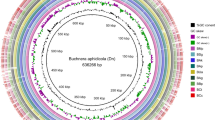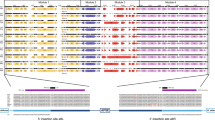Abstract
The bacterial endosymbionts (Buchnera) from the aphidsRhopalosiphum padi, R. maidis, Schizaphis graminum, andAcyrthosiphon pisum contain the genes for anthranilate synthase (trpEG) on plasmids made up of one or more 3.6-kb units. Anthranilate synthase is the first as well as the rate-limiting enzyme in the tryptophan biosynthetic pathway. The amplification oftrpEG on plasmids may result in an increase of enzyme protein and overproduction of this essential amino acid, which is required by the aphid host. The nucleotide sequence oftrpEG from endosymbionts of different species of aphids is highly conserved, as is an approximately 500-bp upstream DNA segment which has the characteristics of an origin of replication. Phylogenetic analyses were performed usingtrpE andtrpG from the endosymbionts of these four aphids as well as from the endosymbiont ofSchlechtendalia chinensis, in whichtrpEG occurs on the chromosome. The resulting phylogeny was congruent with trees derived from sequences of two chromosome-located bacterial genes (part oftrpB and 16S ribosomal DNA). In turn, trees obtained from plasmid-borne and bacterial chromosome-borne sequences were congruent with the tree resulting from phylogenetic analysis of three aphid mitochondrial regions (portions of the small and large ribosomal DNA subunits, as well as cytochrome oxidase II). Congruence of trees based on genes from host mitochondria and from bacteria adds to previous support for exclusively vertical transmission of the endosymbionts within aphid lineages. Congruence with trees based on plasmid-borne genes supports the origin of the plasmid-bornetrpEG from the chromosomal genes of the same lineage and the absence of subsequent plasmid exchange among endosymbionts of different species of aphids.
Similar content being viewed by others
References
Alexeyev MF (1995) Three kanamycin resistance gene cassettes with different polylinkers. Biotechniques 18:52–54
Anderson RP, Roth JR (1977) Tandem genetic duplications in phage and bacteria. Annu Rev Microbiol 31:473–505
Baumann P, Baumann L (1994) Growth kinetics of the endosymbiont,Buchnera aphidicola, in the aphidSchizaphis graminum. Appl Env Microbiol 60:3440–3443
Baumann P, Baumann L, Lai C-Y, Rouhbakhsh D, Moran NA, Clark MA (1995a). Genetics, physiology, and evolutionary relationships of the genusBuchnera: intracellular symbionts of aphids. Annu Rev Microbiol 49:55–94
Baumann P, Lai C-Y, Baumann L, Rouhbakhsh D, Moran NA, Clark MA (1995b) Mutualistic association of aphids and prokaryotes: biology of the genusBuchnera. Appl Environ Microbiol 61:1–7
Blackman RL, Eastop VF (1984) Aphids on the World's Crops. Wiley, Chichester
Bracho AM, Martínez-Torres D, Moya A, Latorre A (1995) Discovery and molecular characterization of a plasmid localized inBuchnera sp., bacterial endosymbiont of the aphidRhopalosiphum padi. J Mol Evol 41:67–73
Campbell A (1981) Evolutionary significance of accessory DNA elements in bacteria. Annu Rev Microbiol 35:55–83
Dadd RH (1985) Nutrition: organisms. In: Kerkut GA, Gilbert GI (eds) Comprehensive insect physiology biochemistry and pharmacology, vol. 4. Pergamon, Elmsford, pp 315–319
Dixon AFG (1985) Aphid ecology. Blackie, London
Douglas AE (1989) Mycetocyte symbiosis in insects. Biol Rev Camb Philos Soc 64:409–434
Douglas AE (1993) The nutritional quality of phloem sap utilized by natural aphid populations. Ecol Entomol 18:31–38
Douglas AE, Prosser WA (1992) Synthesis of the essential amino acid tryptophan in the pea aphid (Acyrthosiphon pisum) symbiosis. J Insect Physiol 38:565–568
Genetics Computer Group (1994) Program manual for the Wisconsin package, version 8. University of Wisconsin, Madison, Wisconsin
Georgopoulos C (1989) TheE. coli dnaA initiation protein: a protein for all seasons. Trends Genet 5:319–321
Harding NE, Cleary JM, Smith DW, Michon JJ, Brusilow WSA, Zyskind JW (1982) Chromosomal replication origins (oriC) ofEnterobacter aerogenes andKlebsiella pneumoniae are functional inEscherichia coli. J Bacteriol 52:983–993
Houk EJ, Griffiths GW (1980) Intracellular symbiotes of the Homoptera. Annu Rev Entomol 25:161–187
Huang K-J, Schieberl JL, Igo MM (1994) A distant upstream site involved in the negative regulation of theEscherichia coli ompF gene. J Bacteriol 176:1309–1315
Ishikawa H (1989) Biochemical and molecular aspects of endosymbiosis in insects. Int Rev Cytol 116:1–45
Kingsbury DT, Helinski DR (1973) Temperature-sensitive mutants for the replication of plasmids inEscherichia coli: requirement for deoxyribonucleic acid polymerase I in the replication of plasmid ColE1. J Bacteriol 114:1116–1124
Kumar S, Tamura K, Nei M (1994) MEGA, Molecular evolutionary genetics analysis, version 1.01. Institute of Molecular Evolutionary Genetics. The Pennsylvania State University, University Park, PA
Lai CY, Baumann L, Baumann P (1994) Amplification oftrpEG; adaptation of Buchnera aphidicola to an endosymbiotic association with aphids. Proc Natl Acad Sci USA 91:3819–3823
Lai CY, Baumann P, Moran NA (1995) Genetics of the tryptophan biosynthetic pathway of the prokaryotic endosymbiont (Buchnera) of the aphidSchlechtendalia chinensis. Insect Mol Biol 4:47–59
Maloy SR, Cronan JE, Freifelder D (1994) Microbial genetics. Jones and Bartlet, Boston
Moran NA (1989) A 48-million-year-old aphid-host plant association and complex life cycle:biogeographic evidence. Science 245:173–175
Moran NA, Baumann P (1994) Phylogenetics of cytoplasmically inherited microorganisms of arthropods. Trends Ecol Evol 9:15–20
Moran NA, Munson MA, Baumann P, Ishikawa H (1993) A molecular clock in endosymbiotic bacteria calibrated using the insect hosts. Proc R Soc Lond [Biol] 253:167–171
Moran NA, von Dohlen CD, Baumann P (in press) Faster evolutionary rates in endosymbiotic bacteria than in cospeciating insect hosts. J Mol Evol 41:727–731
Munson MA, Baumann L, Baumann P (1993)Buchnera aphidicola (a prokaryotic endosymbiont of aphids) contains a putative 16S rRNA operon unlinked to the 23S rRNA-encoding gene: sequence determination, and promoter and terminator analysis. Gene 137:171–178
Munson MA, Baumann P (1993) Molecular cloning and nucleotide sequence of a putativetrpDC(F)BA operon inBuchnera aphidicola (endosymbiont of the aphidSchizaphis graminum). J Bacteriol 175:6426–6432
Rouhbakhsh D, Baumann P (1995) Characterization of a putative 23S-5S rRNA operon ofBuchnera aphidicola (endosymbiont of aphids) unlinked to the 16S rRNA-encoding gene. Gene 155:107–112
Sambrook J, Fritsch EF, Maniatis T (1989) Molecular cloning; a laboratory manual. Cold Spring Harbor Laboratory, Cold Spring Harbor, NY
Simon C, Frati F, Beckenbach A, Crespi B, Liu H, Flook P (1994) Evolution, weighting, and phylogenetic utility of mitochondrial gene sequences and a compilation of conserved polymerase chain reaction primers. Ann Entomol Soc Am 87:651–701
Stern DL (1994) A phylogenetic analysis of soldier evolution in the aphid family Hormaphidinae. Proc R Soc Lond [Biol] 256:203–209
Swofford DL (1993) PAUP: Phylogenetic Analysis Using Parsimony, Version 3.1.1. Computer program distributed by the Illinois Natural History Survey, Champaign, IL
Takada H (1991) Gall development ofSchlechtendalia chinensis (Bell) (Homoptera: Pemphigidae) on Rhus javanica L. and emergence of alatae from galls. Jpn J Appl Entomol Zool 35:71–76
von Dohlen CD, Moran NA (1995) Molecular phylogeny of the Homoptera: a paraphyletic taxon. J Mol Evol 41:211–223
Yoshikawa H, Ogasawara N (1991) Structure and function of DnaA and the DnaA-box in eubacteria: evolutionary relationships of bacterial replication origins. Mol Microbiol 5:2589–2597
Author information
Authors and Affiliations
Rights and permissions
About this article
Cite this article
Rouhbakhsh, D., Lai, CY., von Dohlen, C.D. et al. The tryptophan biosynthetic pathway of aphid endosymbionts (Buchnera): Genetics and evolution of plasmid-associated anthranilate synthase (trpEG) within the aphididae. J Mol Evol 42, 414–421 (1996). https://doi.org/10.1007/BF02498635
Received:
Accepted:
Issue Date:
DOI: https://doi.org/10.1007/BF02498635




